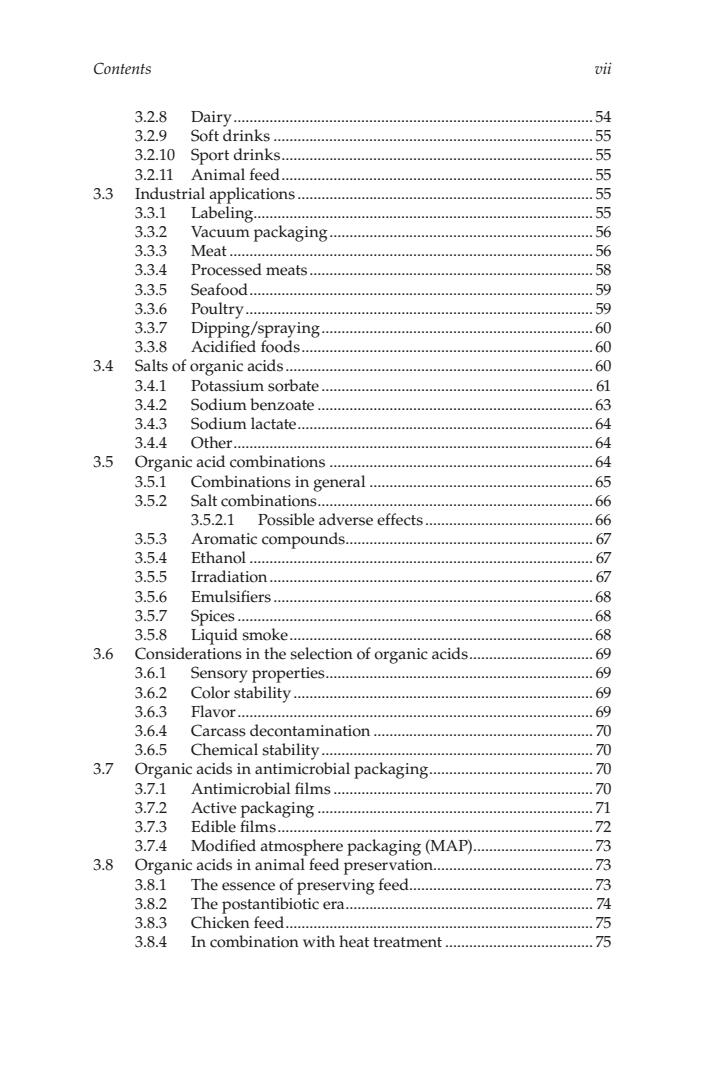正在加载图片...

Contents vi 3.2.8 Dairy. 54 3.2.9 Soft drinks 3.2.10 Sport drinks .55 3211 Animal feed. 55 3.3 55 221 332 uum packaging 56 33 Me 334 Proces ed meats 58 3.3.5 Seafood. 59 3.3.6 Poultry. .59 3.3.7 Dipping/spraving .60 338 Acidified foods 60 3.4 Salts of organic acids. 60 341 Potassi m sorbate 61 243 ate 6 3.4.4 Other.. 35 Organic acid combinations .64 3.5.1 Combinations in general. .65 3.5.2 Salt combinations. .66 3.5.2.1 Possible adverse effects .66 252 Aromatic compounds. 67 354 Ethanol. 67 3.5.5 35.6 Emulsifiers 6 3.5.7 Spices 68 3.5.8 Liquid smoke 68 3.6 Considerations in the selection of organic acids.. .69 3.6.1 Sensory properties. .69 3.62 Color stability 69 262 Flavo 69 364 ss decontamination 70 3.6.5 Ch 0 3.7 Organi c acids s in antimicrobial I packaging. 70 3.7. Antimicrobial films 3.7.2 Active packaging.… .71 3.73 Edible films. .72 3.74 Modified atmosphere packaging(MAP) 73 3.8 Organic acids in animal feed preservation.. .73 381 The ess 72 3.8.2 c era 3.83 Chicke 75 3.8.4 In combination with heat treatment . Contents vii 3.2.8 Dairy.......................................................................................... 54 3.2.9 Soft drinks ................................................................................ 55 3.2.10 Sport drinks.............................................................................. 55 3.2.11 Animal feed.............................................................................. 55 3.3 Industrial applications .......................................................................... 55 3.3.1 Labeling..................................................................................... 55 3.3.2 Vacuum packaging.................................................................. 56 3.3.3 Meat ........................................................................................... 56 3.3.4 Processed meats....................................................................... 58 3.3.5 Seafood...................................................................................... 59 3.3.6 Poultry....................................................................................... 59 3.3.7 Dipping/spraying.................................................................... 60 3.3.8 Acidified foods......................................................................... 60 3.4 Salts of organic acids ............................................................................. 60 3.4.1 Potassium sorbate .................................................................... 61 3.4.2 Sodium benzoate ..................................................................... 63 3.4.3 Sodium lactate.......................................................................... 64 3.4.4 Other.......................................................................................... 64 3.5 Organic acid combinations .................................................................. 64 3.5.1 Combinations in general ........................................................ 65 3.5.2 Salt combinations..................................................................... 66 3.5.2.1 Possible adverse effects .......................................... 66 3.5.3 Aromatic compounds.............................................................. 67 3.5.4 Ethanol ...................................................................................... 67 3.5.5 Irradiation................................................................................. 67 3.5.6 Emulsifiers ................................................................................ 68 3.5.7 Spices ......................................................................................... 68 3.5.8 Liquid smoke............................................................................ 68 3.6 Considerations in the selection of organic acids............................... 69 3.6.1 Sensory properties................................................................... 69 3.6.2 Color stability........................................................................... 69 3.6.3 Flavor......................................................................................... 69 3.6.4 Carcass decontamination ....................................................... 70 3.6.5 Chemical stability.................................................................... 70 3.7 Organic acids in antimicrobial packaging......................................... 70 3.7.1 Antimicrobial films ................................................................. 70 3.7.2 Active packaging ..................................................................... 71 3.7.3 Edible films............................................................................... 72 3.7.4 Modified atmosphere packaging (MAP).............................. 73 3.8 Organic acids in animal feed preservation........................................ 73 3.8.1 The essence of preserving feed.............................................. 73 3.8.2 The postantibiotic era.............................................................. 74 3.8.3 Chicken feed............................................................................. 75 3.8.4 In combination with heat treatment ..................................... 75